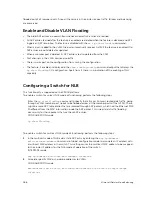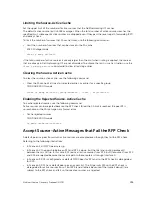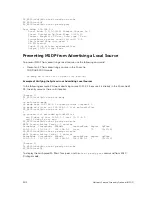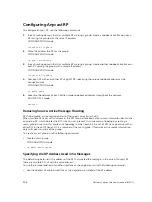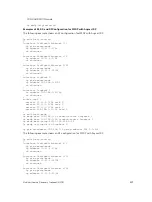
Limiting the Source-Active Cache
Set the upper limit of the number of active sources that the Dell Networking OS caches.
The default active source limit is 500K messages. When the total number of active sources reaches the
specified limit, subsequent active sources are dropped even if they pass the reverse path forwarding (RPF)
and policy check.
To limit the number of sources that SA cache stores, use the following command.
• Limit the number of sources that can be stored in the SA cache.
EXEC Privilege mode
show ip msdp sa-limit
If the total number of active sources is already larger than the limit when limiting is applied, the sources
that are already in Dell Networking OS are not discarded. To enforce the limit in such a situation, use the
clear ip msdp sa-cache
command to clear all existing entries.
Clearing the Source-Active Cache
To clear the source-active cache, use the following command.
• Clear the SA cache of all, local, or rejected entries, or entries for a specific group.
CONFIGURATION mode
clear ip msdp sa-cache [group-address | local | rejected-sa]
Enabling the Rejected Source-Active Cache
To cache rejected sources, use the following command.
Active sources can be rejected because the RPF check failed, the SA limit is reached, the peer RP is
unreachable, or the SA message has a format error.
• Cache rejected sources.
CONFIGURATION mode
ip msdp cache-rejected-sa
Accept Source-Active Messages that Fail the RFP Check
A default peer is a peer from which active sources are accepted even though they fail the RFP check.
Referring to the following illustrations:
• In Scenario 1, all MSPD peers are up.
• In Scenario 2, the peership between RP1 and RP2 is down, but the link (and routing protocols)
between them is still up. In this case, RP1 learns all active sources from RP3, but the sources from RP2
and RP4 are rejected because the reverse path to these routers is through Interface A.
• In Scenario 3, RP3 is configured as a default MSDP peer for RP1 and so the RPF check is disregarded
for RP3.
• In Scenario 4, RP1 has a default peer plus an access list. The list permits RP4 so the RPF check is
disregarded for active sources from it, but RP5 (and all others because of the implicit deny all) are
subject to the RPF check and fail, so those active sources are rejected.
Multicast Source Discovery Protocol (MSDP)
495
Содержание Z9000
Страница 1: ...Dell Configuration Guide for the Z9000 System 9 7 0 0 ...
Страница 80: ...grub reboot 80 Management ...
Страница 128: ... 0 Te 1 1 Te 1 2 rx Flow N A N A 128 Access Control Lists ACLs ...
Страница 436: ...Figure 50 Inspecting Configuration of LAG 10 on ALPHA 436 Link Aggregation Control Protocol LACP ...
Страница 439: ...Figure 52 Inspecting a LAG Port on BRAVO Using the show interface Command Link Aggregation Control Protocol LACP 439 ...
Страница 440: ...Figure 53 Inspecting LAG 10 Using the show interfaces port channel Command 440 Link Aggregation Control Protocol LACP ...
Страница 491: ...Figure 70 Configuring OSPF and BGP for MSDP Multicast Source Discovery Protocol MSDP 491 ...
Страница 492: ...Figure 71 Configuring PIM in Multiple Routing Domains 492 Multicast Source Discovery Protocol MSDP ...
Страница 496: ...Figure 73 MSDP Default Peer Scenario 1 496 Multicast Source Discovery Protocol MSDP ...
Страница 497: ...Figure 74 MSDP Default Peer Scenario 2 Multicast Source Discovery Protocol MSDP 497 ...
Страница 498: ...Figure 75 MSDP Default Peer Scenario 3 498 Multicast Source Discovery Protocol MSDP ...
Страница 760: ...Figure 100 Single and Double Tag TPID Match 760 Service Provider Bridging ...
Страница 761: ...Figure 101 Single and Double Tag First byte TPID Match Service Provider Bridging 761 ...






